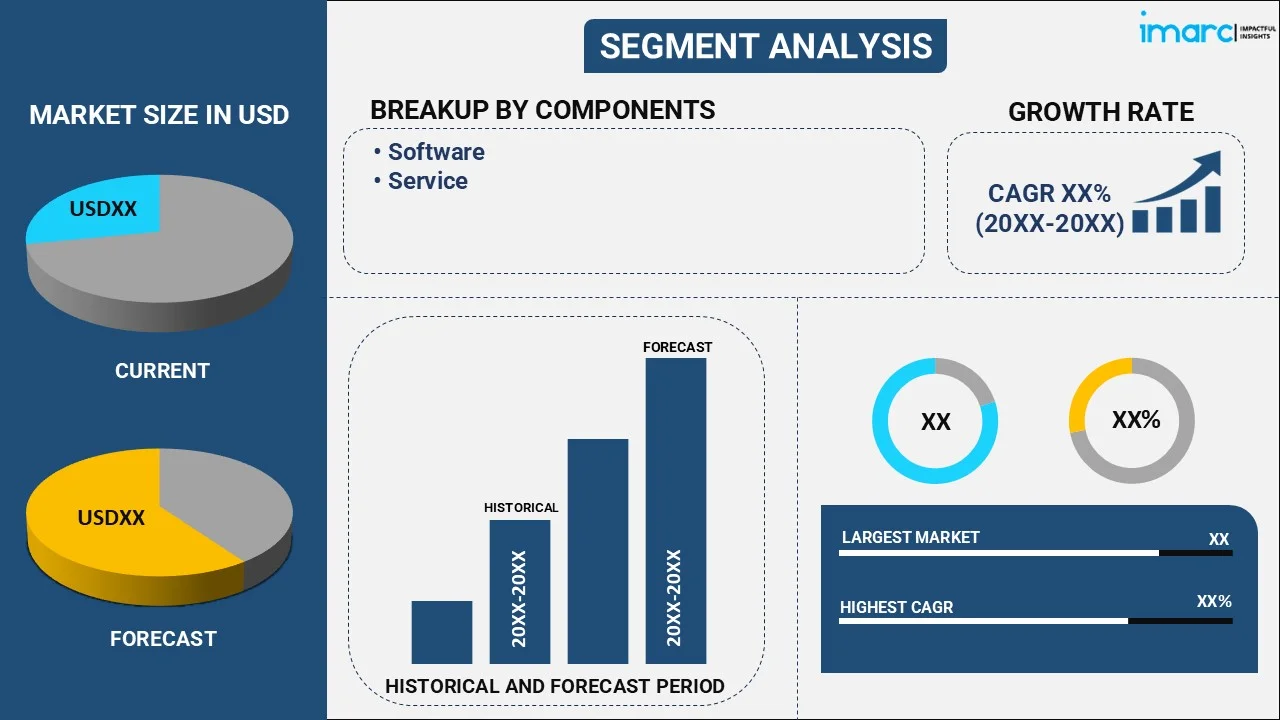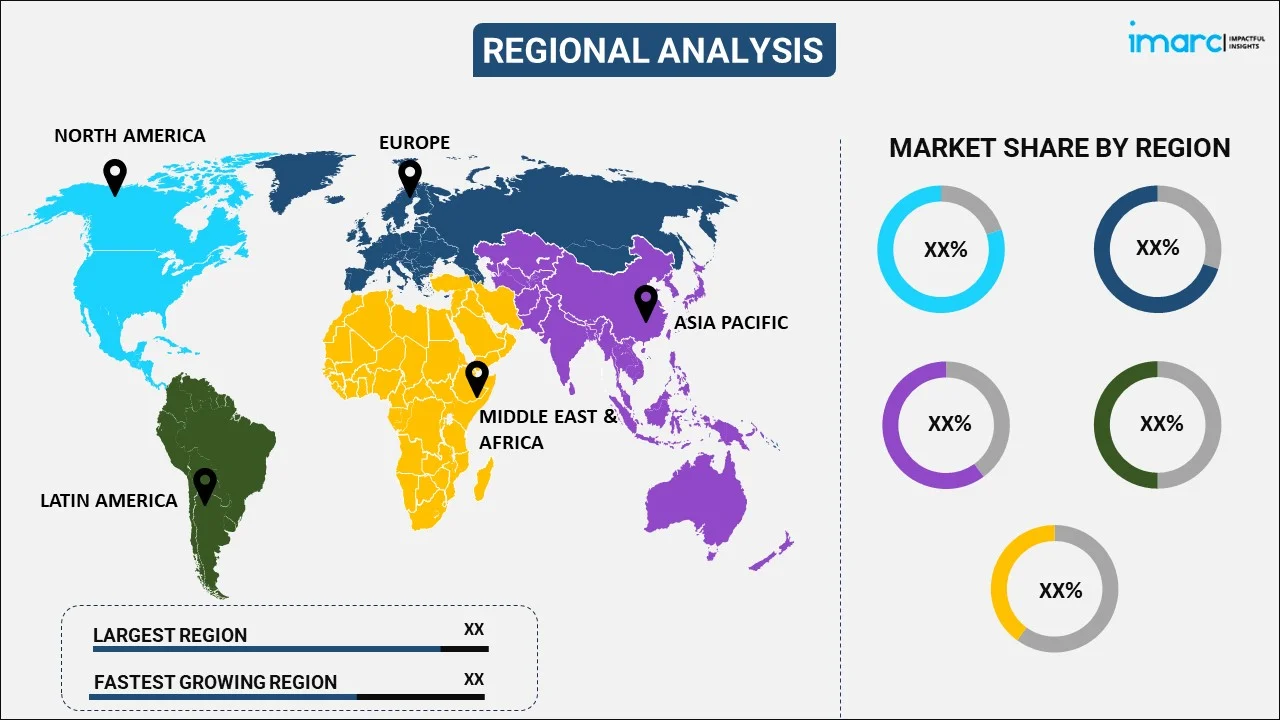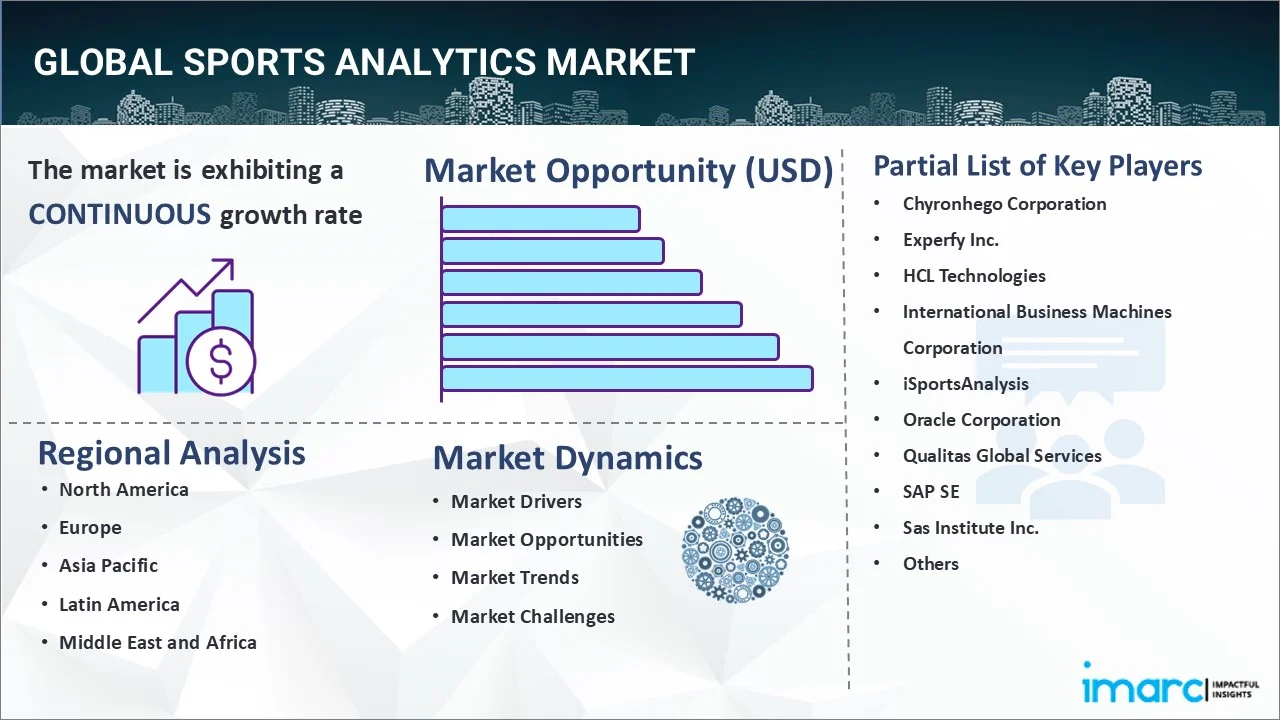
Sports Analytics Market Report by Component (Software, Service), Analysis Type (On-field, Off-field), Sport (Football, Cricket, Hockey, Basketball, American Football, and Others), and Region 2025-2033
Sports Analytics Market Size:
The global sports analytics market size reached USD 1,496 Million in 2024. Looking forward, IMARC Group expects the market to reach USD 5,511.1 Million by 2033, exhibiting a growth rate (CAGR) of 15.6% during 2025-2033. The market is experiencing steady growth driven by the rising demand for enhancing athlete performance and operational efficiencies in competitive sports, the accelerating integration of advanced technologies such as AI and machine learning, and the expansion of sports betting and fantasy sports globally.
|
Report Attribute
|
Key Statistics
|
|---|---|
|
Base Year
|
2024
|
|
Forecast Years
|
2025-2033
|
|
Historical Years
|
2019-2024
|
|
Market Size in 2024
|
USD 1,496 Million |
|
Market Forecast in 2033
|
USD 5,511.1 Million |
| Market Growth Rate 2025-2033 | 15.6% |
Sports Analytics Market Analysis:
- Major Market Drivers: The main factor for the sports analytics market growth is the escalating utilization of data to enhance the performances of players and the strategy of a team. The use of advanced metrics can derive a competitive advantage for teams, hence driving the sports analytics industry. Integration with AI and ML to derive deeper actionable insights from large datasets further propels the market.
- Key Market Trends: The recent sports analytics market trends include growing demand for real-time data analysis with an access device, leading to an increase in cloud-based analytics solutions. As several teams and leagues adopt these technologies, the use of sports analytics is increasing in personalizing the fan experience and thereby driving loyalty.
- Geographical Trends: North America is the leading market for the sports analytics landscape, based on strong sports infrastructure, high adoption rates of advanced technologies, and the trend of sports betting. Fast-growing geographies include Europe and Asia-Pacific, which are driven by growing investments in sports technologies and the growing sports league.
- Competitive Landscape: According to the sports analytics market analysis, the market is moderately fragmented in nature. IBM, SAP, and Oracle are some of the leading companies that provide very robust solutions tailored to sports teams and leagues. Small companies and start-ups are also getting into the market with more innovative tools and technologies for analytics, hence raising the competition.
- Challenges and Opportunities: The main challenges are the high costs of deployment of advanced analytics solutions and concerns related to data privacy and security. However, the rise of more affordable and secure analytics solutions that benefit a wider spectrum of sports organizations, ranging from amateur leagues to educational institutions are some of the sports analytics market recent opportunities.
Sports Analytics Market Trends:
Increasing demand for player performance enhancement and team efficiency
Competitive sports are increasingly technologically driven, and the advantages gained may lead to improved performance by players and greater efficiency for teams, based on analysis conducted by coaches. Sports analytics help to derive insights about player health, performance patterns, and tactical strategies to guide a coach in decision-making and strategy formulation. The sports analytics market recent developments include modern analytical tools, which use wearable technologies and video analysis, and make use of deep metrics to obtain information about player fitness, game dynamics, and injury prevention. Consequently, developing data-driven decisions fine-tunes athletic performance, thus augmenting outcomes and enhancing the team's competitive edge in leagues and tournaments. Therefore, this is significantly supporting the market growth.
Integration of advanced technologies such as AI and machine learning
The role of artificial intelligence and machine learning in transforming the sports analytics market is massive. They further enhance the analytic functions of the sports data systems for the derivation of insightful, deep, and accurate inferences from large sets of data. It runs deep, from the prediction of player injuries to fan engagement through personalized experiences. With predictive analytics, organizations make informed decisions that prevent injuries, optimize line-ups, and maximize strategy effectiveness. For instance, Sparta Science is applying AI with a high-speed force-plate system, collecting 3,000 data points per second, creating "Movement Signatures" with baseball athletes, and optimizing training programs. Therefore, the adoption of such technological enhancements among stakeholders to exploit complete, real-time insights and stay ahead in the sports business is fostering a positive sports analytics market outlook.
Expansion of sports betting and fantasy sports
The key growth drivers for the sports analytics market are the increasing popularity of fantasy sports and the legal expansion of sports betting in many parts of the world. Recently, SportsBaazi (formerly BalleBaazi), a fantasy-gaming platform, recorded a 60% increase in playing users month-over-month during the World Cup. The platform has been retaining an active user base of over 400,000 players, with new signups up 40%. Thus, this is positively influencing the sports analytics market revenue. Analytics in these sectors help the bettors and participants of fantasy sports in making informed decisions and deriving proper predictions with data-driven insights for the best possible results. The system provides information on player performance analytics, game results, and real-time data feeds to make the betting experience better and increase the level of engagement of the participants. Additionally, the increasing demand for accurate predictions and in-depth player statistics in these markets leads to higher investments in sports analytics solutions and their adoption by the betting and fantasy sports industries.
Sports Analytics Market Segmentation:
IMARC Group provides an analysis of the key trends in each segment of the market, along with forecasts at the global, regional, and country levels for 2025-2033. Our report has categorized the market based on component, analysis type and sport.
Breakup by Component:

- Software
- Service
Software accounts for the majority of the market share
The report has provided a detailed breakup and analysis of the sports analytics market based on the component. This includes software and service. According to the report, software represented the largest segment.
The largest market share in the sports analytics market is of the software segment, as the software is the major constituent wherein aggregation of data takes place, along with its analysis and interpretations. The software segment varies largely, from data management and visualization tools to predictive and prescriptive analytics software, tailor-fitted to refine decision-making about sports management. Demand for sports analytics software is being generated since it helps in holistic insights into player performance, team dynamics, and game strategies, which lets the coach, analysts, and managers make fast and informative decisions. According to the sports analytics market report, the ongoing evolution of these software solutions is set to be in alignment with the evolution of AI and machine learning technologies, which makes it more and more efficient and insightful. In addition, growth in cloud-based analytics software is enhancing this segment: it is easily scalable, user-friendly, and easily accessed remotely, completely meeting the needs of the modern sports organization.
Breakup by Analysis Type:
- On-field
- Player and Team Analysis
- Video Analysis
- Health Assessment
- Off-field
- Fan Engagement
- Ticket Pricing
On-field holds the largest share of the industry
A detailed breakup and analysis of the sports analytics market based on the analysis type has also been provided in the report. This includes on-field (player and team analysis, video analysis, and health assessment) and off-field (fan engagement and ticket pricing). According to the report, on-field accounted for the largest market share.
On-field analysis seems to be the largest segment of the sports analytics market since it deals directly with the decision-making on the field, during play and practice and hence offers immediate payoff. Performance analysis is known as on-field analysis because it is directly related to actual performance on the field. It offers important information to design game strategies, player setups, and tactical set-ups for in-game situations. These are performance-based analytics employed for improvising the actual performance of players or teams through strategies that are based on real-time data and the historical performance of those players or teams. On-field analytics gives teams vital information needed to design game strategies, player set-up, and tactical configuration for game situations. Tools are used for on-field analysis, such as player tracking systems, video analysis software, and wearable technology, among others. Thus, their increasing demand is propelling the sports analytics market growth.
Breakup by Sport:
- Football
- Cricket
- Hockey
- Basketball
- American Football
- Others
Football represents the leading market segment
A detailed breakup and analysis of the sports analytics market based on the sport has also been provided in the report. This includes football, cricket, hockey, basketball, American football, and others. According to the report, football accounted for the largest market share.
Football drives the highest share in the sports analytics market. The sports analytics market forecast suggests that football will continue its dominance in the segment due to its global popularity and well-established professional infrastructure. With football being the most popular sport watched and played worldwide, teams and associations invest heavily in analytics for competitive advantages, performance optimization, and making better tactical decisions. It is quite dynamic and complex, with the main aspects focusing on strategy, player fitness, and team coordination. The insights, in turn, are data-driven and fine-tune anything from the role of an individual player to the formation of a team, how to prevent injuries, and even scouting new talent. Therefore, analytics has been used in a wide way in football, considering higher stakes to make it to the leagues and win a match, as well as the prospect of earning revenues in football competitions. The sports analytics market overview suggests that innovations of advanced analytical tools and software in football are in high demand every passing day, driving innovation and expansion further in this segment of the sports analytics market.
Breakup by Region:

- North America
- United States
- Canada
- Asia-Pacific
- China
- Japan
- India
- South Korea
- Australia
- Indonesia
- Others
- Europe
- Germany
- France
- United Kingdom
- Italy
- Spain
- Russia
- Others
- Latin America
- Brazil
- Mexico
- Others
- Middle East and Africa
North America leads the market, accounting for the largest sports analytics market share
The report has also provided a comprehensive analysis of all the major regional markets, which include North America (the United States and Canada); Asia Pacific (China, Japan, India, South Korea, Australia, Indonesia, and others); Europe (Germany, France, the United Kingdom, Italy, Spain, Russia, and others); Latin America (Brazil, Mexico, and others); and the Middle East and Africa. According to the report, North America represents the largest regional market for sports analytics.
North America holds the largest sports analytics market share. This can be attributed to advanced technological infrastructure, high investment levels in the domain of sports and related technologies, and a deeply ingrained sports culture. Analysts put analytics into play in most, if not all, aspects of team operations to enhance team performance, player health management, and fan engagement, among other things. In addition, North America is ahead in frontier technology adoption, such as artificial intelligence and machine learning, which play crucial roles in modern sports analytics. Broad legalization of sports betting across the region further augments the sports analytics demand, as stakeholders use such data-driven insights to make betting decisions or to enhance user engagement on fantasy sports platforms.
Competitive Landscape:
The market research report has also provided a comprehensive analysis of the competitive landscape in the market. Detailed profiles of all major companies have also been provided. Some of the major market players in the sports analytics industry include:
- Chyronhego Corporation
- Experfy Inc.
- HCL Technologies
- International Business Machines Corporation
- iSportsAnalysis
- Oracle Corporation
- Qualitas Global Services
- SAP SE
- SAS Institute Inc.
- Sportradar AG
- Stats Perform
- Tableau Software LLC (Salesforce.com Inc.)
(Please note that this is only a partial list of the key players, and the complete list is provided in the report.)
Major sports analytics companies in this market space include IBM, SAP, Oracle, and SAS, which are increasingly updating their offerings with the infusion of advanced technologies such as artificial intelligence or machine learning. They also have an eye on the wider deployment of these technologies across sports leagues and teams in the world, enabled by strategic partnerships. They are also investing in various cloud-based solutions to make sports analytics scalable and accessible to a growing clientele across the globe. The sports analytics market forecast suggests that major companies are seeking to build an even more sophisticated analytics tool that will provide deeper insights into game performance metrics and player health to optimize team performance and minimize injury.
Sports Analytics Market News:
- June 21, 2023: International Business Machines Corporation launched a new Artificial Intelligence feature by making use of generative AI technology to create tennis commentary for every video highlight package throughout Wimbledon.
- January 06, 2021: Chyronhego Corporation announced that it has completed a recapitalization to be led by Apollo Investment Corporation, which is also becoming the largest investor in the business. This transaction provides ChyronHego with greater financial flexibility to increase investments in product innovation, customer success, and business growth.
Sports Analytics Market Report Scope:
| Report Features | Details |
|---|---|
| Base Year of the Analysis | 2024 |
| Historical Period | 2019-2024 |
| Forecast Period | 2025-2033 |
| Units | Million USD |
| Scope of the Report | Exploration of Historical Trends and Market Outlook, Industry Catalysts and Challenges, Segment-Wise Historical and Future Market Assessment:
|
| Components Covered | Software, Service |
| Analysis Types Covered |
|
| Sports Covered | Football, Cricket, Hockey, Basketball, American Football, Others |
| Regions Covered | Asia Pacific, Europe, North America, Latin America, Middle East and Africa |
| Countries Covered | United States, Canada, Germany, France, United Kingdom, Italy, Spain, Russia, China, Japan, India, South Korea, Australia, Indonesia, Brazil, Mexico |
| Companies Covered | Chyronhego Corporation, Experfy Inc., HCL Technologies, International Business Machines Corporation, iSportsAnalysis, Oracle Corporation, Qualitas Global Services, SAP SE, Sas Institute Inc., Sportradar AG, Stats Perform, Tableau Software LLC (Salesforce.com Inc.), etc. |
| Customization Scope | 10% Free Customization |
| Post-Sale Analyst Support | 10-12 Weeks |
| Delivery Format | PDF and Excel through Email (We can also provide the editable version of the report in PPT/Word format on special request) |
Key Benefits for Stakeholders:
- IMARC’s industry report offers a comprehensive quantitative analysis of various market segments, historical and current market trends, market forecasts, and dynamics of the sports analytics market from 2019-2033.
- The research report provides the latest information on the market drivers, challenges, and opportunities in the global sports analytics market.
- The study maps the leading, as well as the fastest-growing, regional markets. It further enables stakeholders to identify the key country-level markets within each region.
- Porter's five forces analysis assists stakeholders in assessing the impact of new entrants, competitive rivalry, supplier power, buyer power, and the threat of substitution. It helps stakeholders to analyze the level of competition within the sports analytics industry and its attractiveness.
- The competitive landscape allows stakeholders to understand their competitive environment and provides insight into the current positions of key players in the market.
Key Questions Answered in This Report
The global sports analytics market was valued at USD 1,496 Million in 2024.
We expect the global sports analytics market to exhibit a CAGR of 15.6% during 2025-2033.
The growing prominence of sports analytics, owing to the continuous advancements in the sports industry for making data-driven decisions and developing team strategies, is primarily driving the global sports analytics market.
The sudden outbreak of the COVID-19 pandemic has led to the rising integration of sports analytics with wearable devices for keeping track of fitness variables, such as acceleration, heart rate, calorie intake, etc., owing to the increasing health-consciousness among the consumers.
Based on the component, the global sports analytics market can be categorized into software and services, where software exhibits a clear dominance in the market.
Based on the analysis type, the global sports analytics market has been segmented into on-field and off-field. Currently, on-field analysis represents the largest market share.
Based on the sport, the global sports analytics market can be bifurcated into football, cricket, hockey, basketball, American football, and others. Among these, football currently accounts for the majority of the total market share.
On a regional level, the market has been classified into North America, Europe, Asia-Pacific, Middle East and Africa, and Latin America, where North America currently dominates the global market.
Some of the major players in the global sports analytics market include Chyronhego Corporation, Experfy Inc., HCL Technologies, International Business Machines Corporation, iSportsAnalysis, Oracle Corporation, Qualitas Global Services, SAP SE, Sas Institute Inc., Sportradar AG, Stats Perform, and Tableau Software LLC (Salesforce.com Inc.).
Need more help?
- Speak to our experienced analysts for insights on the current market scenarios.
- Include additional segments and countries to customize the report as per your requirement.
- Gain an unparalleled competitive advantage in your domain by understanding how to utilize the report and positively impacting your operations and revenue.
- For further assistance, please connect with our analysts.

 Inquire Before Buying
Inquire Before Buying
 Speak to an Analyst
Speak to an Analyst
 Request Brochure
Request Brochure
 Request Customization
Request Customization




.webp)




.webp)












